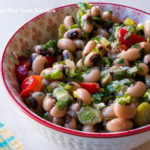Let’s face it; most of us eat way too much salt. A high-sodium diet can increase risk of high blood pressure (hypertension), which can lead to cardiovascular and kidney disease. The Dietary Guidelines for Americans recommend limiting sodium intake to less than 2,300 mg per day, which is about 1 teaspoon of salt. The good news is that reducing the amount of salt you use will retrain your taste buds to sense other flavors. You won’t even miss it.
Bland food is such a bore, but how can we keep sodium in check without sacrificing flavor?
Here are some suggestions to reduce salt in your diet:
Remove the salt shaker from the table when you eat.
Limit process foods, including cured, pickled, salted, or brined products.
Focus on fresh or frozen fruits and vegetables without sauces or seasonings.
When choosing canned options, look for “no salt added” or “low sodium.”
Cook at home so you have control over how much salt you add.
Flavored vinegar, onions, garlic, and citrus also add tons of flavor without the sodium.
Herbs and spices are the key to flavor. Add dried varieties during cooking and fresh herbs at the end of cooking or when plating a dish. Thyme, mint, lemongrass, dill, basil, oregano, chives, and parsley are great herbs to use. Spices like pepper, ginger, chili powder, and cinnamon are excellent spices to flavor your food.
“Work With What You Got!”
©Tiny New York Kitchen © 2018 All Rights Reserved
Welcome Spring. We rejoice in longer days and the vision of growth and rebirth after a long winter. The seeds planted last autumn have germinated over the winter, have become buds, and are beginning to break through the cold earth. These are signs of renewal and hope that start to stir within each of us. The seeds of change that we planted within ourselves now push through with the new energy we feel. A sense of renewal gives us the vision and inspiration to bring our creative energy to fruition.
“Work With What You Got!”
©Tiny New York Kitchen © 2018 All Rights Reserved
Whether you’re a frequent or an occasional restaurant diner it’s nice to know a few inside tips on how to maximize your experience.
If you’re health conscious, don’t buy into claims that the food you order will meet your needs. Most restaurants don’t make food that’s healthy. They’re job is to make it taste good. Restaurants put so much butter on everything they serve. It’s difficult to find a healthy option today.
Always ask your server if there is anything on the menu you should steer away from. If your server say, “That would be the last thing I’d choose,” there is a good reason.
Rib eye is the best steak to order. It’s more flavorful and very tender. Don’t just say “medium rare.” Give your server a description of what the middle of the steak looks like – “all pink from edge to edge” or “I like it all red.” Everyone has a different idea of what the middle should be.
If you drink alcohol, the best bang for your buck is either beer or wine. Hard liquor is the most expensive, for what you’re getting.
“Work With What You Got!”
©Tiny New York Kitchen © 2018 All Rights Reserved
It’s that time of year again, in America, when the beer turns green and the aroma of corned beef and cabbage fills the air. The dish is so comforting, but just what is corned beef? The term has nothing to do with corn, but was the English term for a small granule, such as a grain of salt. In days before modern refrigeration, salting meat was a way to preserve it and keep it from spoiling.
Corned beef is an Americanized addition to the traditional Irish diet. While colcannon (boiled potatoes, cabbage, and leeks in buttermilk flavored with wild garlic) was a common Irish dish, as was brown soda bread, corned beef was produced primarily for export to England. Upon arriving in America, however, it’s thought the Irish chose to celebrate their holiday with food that was typically not available to them in their home country, so corned beef was added to the menu, as was white soda bread studded with currants and caraway.
Corned beef is typically made from beef brisket, which is a cut of meat from the breast or lower chest, but the rump, bottom round, and even tongue, can be used. In America, the term “corned beef” is used to describe both the cured meat and the canned stuff found on grocery store shelves. In Britain, they call the canned stuff “salt beef.”
To make corned beef the meat is simmered in a blend of corned beef spices that usually include peppercorns, garlic, mustard, tarragon, thyme, parsley, cloves, and nutmeg.
In New England, you most often see corned beef served as a St. Patrick’s Day main dish or in a sandwich. As the main ingredient in New England Boiled Dinner, corned beef often pairs with potatoes, carrots, turnips, and cabbage in a hearty, savory, brothy bowl of goodness. When used in a sandwich, the most popular corned beef sandwich is the Reuben. Considered the quintessential Jewish deli sandwich, a Reuben is toasted rye bread stuffed with hot slices of corned beef, usually piled high, and topped with sauerkraut, Swiss cheese, and either Russian or Thousand Island dressing.
In New England, a frequent point of interest is also whether you prefer red vs. gray corned beef. The difference is “Red” brisket is cured with nitrite, which gives the meat its signature color. “Gray” corned beef, which is considered the authentic New England variety, is not cured with nitrate, so color forms naturally as it brines.
If you have corned beef leftovers a New England favorite is corned beef hash, which is typically served for breakfast.
“Work With What You Got!”
©Tiny New York Kitchen © 2018 All Rights Reserved
Olive oil is rich in unsaturated fat and is also an anti-inflammatory, but all olive oils aren’t created equally. As you may have heard, not all imported olive oil is 100% pure olive oil because it’s mixed with other types of oils. It’s important to know what type of olive oil you’re purchasing. To avoid spoilage make sure to store olive oil away from heat, air, and light. Here is a quick guide on selecting oil for all of your cooking needs.
EXTRA VIRGIN
Extra virgin olive oil comes from the olive’s first cold press. The highest quality unrefined oil available; EVOO has a pure, fruity flavor and is best used for drizzling on salads, vegetables, and proteins and dipping bread into.
ORGANIC
Organic olive oil is very similar to extra virgin in terms of how it’s made, the quality, and the flavor. The difference is that organic olive oil is made using only certified organic olives.
LIGHT
“Light” refers to flavor, not fat or calories. Light olive oil is a refined oil that has a high smoke point and neutral flavor, so it’s great for frying, sautéing, and baking.
PURE
If you need an all-purpose cooking oil, pure olive oil fits the bill. It’s a blend of virgin and refined oils, leaving it with a neutral taste.
“Work With What You Got!”
©Tiny New York Kitchen © 2018 All Rights Reserved
In Winter Months I Like To Force Bulbs Indoor, Which Fills My Home With Blossoms. It’s Very Easy To Do With Just A Few Simple Steps. You Will Need To Chill The Bulbs If They’ve Not Already Been Chilled. Place Them In The Crisper Drawer Of Your Refrigerator For At Least 5 Weeks (Keep Them Away From Any Produce). Wear Gloves When Handling The Bulbs. Fill A Forcing Vase To Just Below The Cup Where The Bulb Will Rest. Place The Bulb In The Cup, Root End Down And Growing End Up So The Bulb Base Is Barely Touching The Water. Place The Vase On A Sunny Windowsill And Watch As It Begins To Bloom. Periodically Change The Water And Keep The Water Level At The Base Of The Bulb. Turn Each Day To Keep It Growing Upright. Forced Bulbs Don’t Usually Make The Transition To The Outside Garden So When They’re Done Throw Them In The Compost Bin.
“Work With What You Got!”
©Tiny New York Kitchen © 2018 All Rights Reserved
Here is another use for the whole grains and seeds that you’re seeing at the store. Top off with delicious flavoring, which are also tasty on oatmeal.
Amaranth (3/4 Cup)
Bring 2 1/4 cups water or milk to boil in saucepan. Stir in amaranth. Reduce heat to low, cover and simmer until tender. Cooking time is 25 to 30 minutes. Stir occasionally. Remove from heat and mix in or top with dried cherries, coconut sugar, macadamia nuts, vanilla, banana, or cacao nibs. Serves 2
Millet (3/4 Cup)
Bring 1 1/2 cups water or milk to boil in saucepan. Stir in millet. Reduce heat to low, cover and simmer until tender. Cooking time is 15 to 20 minutes. Stir occasionally. Remove from heat and mix in or top with chopped dates, demerara sugar, hazelnuts, cloves, clementine, or granola. Serves 2
Quinoa (3/4 Cup)
Bring 1 1/2 cups water or milk to boil in saucepan. Stir in quinoa. Reduce heat to low, cover and simmer until tender. Cooking time is 15 to 20 minutes. Stir occasionally. Remove from heat and mix in or top with dried apricots, agave syrup, pine nuts, cardamom, blueberries, or toasted coconut.
Serves 2
“Work With What You Got!”
©Tiny New York Kitchen © 2018 All Rights Reserved
Use The Leaves
The leafy green stems of beets or radishes make a tasty side dish when sautéed with garlic and olive oil. Try blending carrot greens with olive oil, Parmesan cheese, and a squeeze of lemon for a tasty pesto.
Slice The Stems
Broccoli stalks are the perfect size for spiralizing and make a crunchy addition to salads.
Zest The Rind
Citrus peels are packed with sweetness. Their flavorful zest will elevate any marinade, vinaigrette, or dessert.
Vegetable Stock
And, of course, you can make homemade vegetable stock.
“Work With What You Got!”
©Tiny New York Kitchen © 2018 All Rights Reserved
Going out for dinner on Valentine’s Day is a risky affair. Even the best restaurants can have “overload difficulties” on such a busy night where couples have expectations of restaurant perfection. A better way to manage expectations is to take control of them yourself. Food is a language of love. You know what you like and what your loved one likes. No need to worry about cheesy love songs or a perfumed soaked lady sitting next to you. Nothing says I love you more than taking the time to make a special meal for the person you love. Visit the local farmers’ market, butcher, or seafood shop to buy their favorite seasonal ingredients. Come up with a meal that celebrates love. Turn off the lights, fire up all the candles and put on your favorite music.
Keep it easy and made make it special. Plan out the meal from beginning to end to get organized and make sure you have a solid menu. If you’re not a seasoned cook make sure to keep it simple and I recommend not trying to make complicated dishes that you’ve never made before. Make it easy with three courses. Begin with a beautiful cheese plate. Embrace easy, big impact dishes. Start off with prosciutto-wrapped scallops finished with a squeeze of lemon. Warm things up with braised short ribs or steaks finished off with butter and herbs. Keep desserts simple, but sweet. Decorate bakery cakes with fresh fruit or edible flowers or warm up slices of pie and top with caramel sauce and a gourmet ice cream or try your hand at an easy dessert of chocolate pots de crème. Don’t forget that nice bottle of wine or champagne.
“Work With What You Got!”
©Tiny New York Kitchen © 2018 All Rights Reserved















